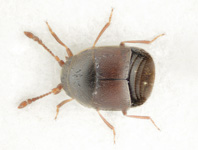Abstract
A new treefrog of the genus Nasutixalus is described from montane evergreen forest in Yingjiang County, in western Yunnan, China. The new species, Nasutixalus yingjiangensis sp. nov., can be distinguished from its congeners by a combination of the following characters: medium body size (SVL 39.5–40.0 mm in adult males, 47.5 mm in a single female); tympanum indistinct and covered with tubercles; disc diameter of third finger greater than tympanum diameter; dorsal skin relatively smooth, scattered with small tubercles, those on head and anterior dorsum of body more dense and more prominent; light brown above with a dark brown marking between eyes and two broad dark brown lateral strips on the dorsum; iris with a weak “X”-shaped, light colored marking; interorbital distance shorter than the upper eyelid width; comparatively short foot (mean TFL/SVL ratio 67.0% and 62.9% in males and female respectively). The new species appears to be forest-dependent and was found in well-preserved montane rainforest; it inhabits the canopy and breeds in tree holes during the rainy season. The type locality of the new species is an isolated forest fragment surrounded by degraded landscape and efforts are already underway to protect the site. Nasutixalus yingjiangensis sp. nov. represents the third known species of the newly established genus Nasutixalus.
References
Biju, S.D., Senevirathne, G., Garg, S., Mahony, S., Kamei, R.G., Thomas, A., Shouche, Y.S., Raxworthy, C.J., Meegaskumbura, M. & Van Bocxlaer, I. (2016) Frankixalus, a new rhacophorid genus of tree hole breeding frogs with oophagous tadpoles. PLoS ONE, 11 (1), e0145727, 1–17.
https://doi.org/10.1371/journal.pone.0145727Chen, X., Chen, Z., Jiang, J., Qiao, L., Lu, Y., Zhou, K., Zheng, G. & Liu, J. (2013) Molecular phylogeny and diversification of the genus Odorrana (Amphibia, Anura, Ranidae) inferred from two mitochondrial genes. Molecular phylogenetics and evolution, 69 (3), 1196–1202.
https://doi.org/10.1016/j.ympev.2013.07.023Darriba, D., Taboada, G.L., Doallo, R. & Posada, D. (2012) jModelTest 2: more models, new heuristics and parallel computing. Nature Methods, 9 (8), 772.
https://doi.org/10.1038/nmeth.2109Edgar, R.C. (2004) MUSCLE: multiple sequence alignment with high accuracy and high throughput. Nucleic acids research, 32, 1792–1797.
Fei, L., Hu, S.Q., Ye, C.Y. & Huang, Y.Z. (2009) Fauna Sinica. Amphibia Vol. 2 Anura. Science Press, Beijing, 957 pp. [in Chinese]
Frost, D.R. (2017) Amphibian Species of the World: an Online Reference. Version 6.0 Electronic Database accessible. American Museum of Natural History, New York, USA. Available from: http://research.amnh.org/herpetology/amphibia/index.html (accessed 9 May 2017)
Jiang, K., Yan, F., Wang, K., Zou, D. H., Li, C. & Che, J. (2016) A new genus and species of treefrog from Medog, southeastern Tibet, China (Anura, Rhacophoridae). Zoological Research, 37 (1), 15–20.
Rambaut A, Suchard M.A., Xie, D. & Drummond, A.J. (2014) Tracer v1.6, Available from: http://beast.bio.ed.ac.uk/Tracer (accessed 30 January 2018)
Ronquist, F., Teslenko, M., van der Mark, P., Ayres, D.L., Darling, A., Höhna, S., Larget, B., Liu, L., Suchard, M.A. & Huelsenbeck, J.P. (2012) MrBayes 3.2: efficient Bayesian phylogenetic inference and model choice across a large model space. Systematic Biology, 61 (3), 539–542.
Savage, J.M. (1975) Systematics and distribution of the Mexican and Central American stream frogs related to Eleutherodactylus rugulosus. Copeia, 1975 (No. 2), 254–306.
https://doi.org/10.2307/1442883Simon, C., Frati, F., Beckenbach, A., Crespi, B., Liu, H. & Flook, P. (1994) Evolution, weighting, and phylogenetic utility of mitochondrial gene sequences and a compilation of conserved polymerase chain reaction primers. Annals of the entomological Society of America, 87 (6), 651–701.
https://doi.org/10.1093/aesa/87.6.651Sivongxay, N., Davankham, M., Phimmachak, S., Phoumixay, K. & Stuart, B.L. (2016) A new small-sized Theloderma (Anura: Rhacophoridae) from Laos. Zootaxa, 4147 (4), 433–442.
https://doi.org/10.11646/zootaxa.4147.4.5Stamatakis, A. (2014) RAxML Version 8: A tool for phylogenetic analysis and post-analysis of large phylogenies. Bioinformatics, 30 (9), 1312–1313.
https://doi.org/10.1093/bioinformatics/btu033Tamura, K., Stecher, G., Peterson, D., Filipski, A. & Kumar, S. (2013) MEGA6: molecular evolutionary genetics analysis version 6.0. Molecular Biology and Evolution, 30 (12), 2725–2729.
https://doi.org/10.1093/molbev/mst197Vences, M., Thomas, M., van der Meijden, A., Chiari, Y. & Vieites, D.R. (2005) Comparative performance of the 16S rRNA gene in DNA barcoding of amphibians. Frontiers in Zoology, 2 (1), 5.

